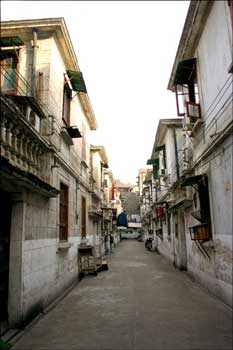The Irresistible Charm of Lifen Architecture in Hankou
Lifen architecture, similar to bystreets in Beijing and Shikumen in Shanghai, is typical of traditional residential buildings in Wuhan. Born in special periods, each of them contain special local cultures of a city and is a main component exhibiting the distinct charm of the city.

Thanks to exchanges between eastern and western cultures, Lifen, as an exemplar of blending Chinese national style with the characteristics of western architecture, was built in Hankou. The buildings are not only the epitome of a nearly 100-year residence of a culture but also the combination of western duplex town houses and our traditional quadrangles after Hankou dock was opened. People have begun to pay more and more attention to the characteristic structures of Lifen and its academic research as well as its aesthetic value which sparkles most brightly in the current city constructions that are deeply influenced by so-called individualization.
The most well-known Lifen in the first stage are Taixing Lane built in 1908 and Xian’an Lane built in at the beginning of the Republic of China. The layout in Xian’an Lane is like a Lifen, but each single house is built in the structure of a villa. Each single house has front and back dooryards which serve as a special space to insulate outside disturbance instead of as a connective space between supplementary houses and main houses for transition in Lifen. Some representative top-grade Lifen are Tongxing Lane which was built in 1932, Liuyecun in 1934 and Jianghancun in 1936.
Generally speaking, Lifen can be classified into four styles and each style is symmetrical in different forms. (1) A main alley runs through with symmetrical branch alleys on both sides such as Sande Lane and Kunhou Lane. (2) A main alley runs through with branch alleys on one side. (3) A main alley runs through with branch alleys alternating on both sides such as Xian’an Lane and Hongwei Lane. (4) A main alley runs through with doors face to face on both sides and some are made asymmetrical so as to create a quiet corner from outside disturbance because of its shortness and straightness. Some big Lifen are the combination of these styles.
Compared with traditional buildings, Lifen attaches importance to the full use of limited land by changing the courtyard between the wing-room and the principal room into a dooryard (smaller than courtyard) and separating the kitchen from the living area in the back dooryard. The backyard is used for transition and ventilation. Because of the mature architectural skills when introduced into Hankou, all houses in Lifen were built with two stories at the beginning.
Hankou is one of the three hottest cities along Yangtze River so there is a lot of attention paid to the design for cooling off inside rooms.
With the rapid development of urban construction, the valuable architecture treasures scattered all over the city appear dilapidated among high buildings and large mansions, but the particular history they carry, the characteristic charm of architecture and the harmonious relationships among neighbors are all infecting us with vitality.
Source: english.wh.gov.cn
Editor: Xu Xinlei
|

